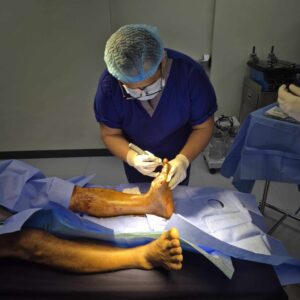Choosing hip replacement surgery is a life-changing decision that can restore mobility, reduce pain, and allow you to return to the activities you love. Many people considering surgery, especially those seeking treatment abroad, often ask how to prepare for hip replacement in a way that ensures the best recovery and outcomes. Preparation is one of the most important steps you can take, as it helps you strengthen your body, plan your recovery environment, and reduce potential complications. At Hips and Knees Joint Restoration and Replacement Center in the Philippines, we guide international patients every step of the way so they can feel confident and ready for their journey.
Understanding Hip Replacement Surgery
Before exploring how to prepare for hip replacement, it’s important to understand what the procedure involves. Hip replacement is a surgical treatment designed to replace a damaged hip joint with an artificial implant. Conditions such as arthritis, fractures, or wear and tear over time can cause significant pain and stiffness, limiting daily activities.
Many patients from the USA, Australia, New Zealand, and the UK consider hip replacement abroad due to high surgery costs or long waiting lists in their home countries. Our center in the Philippines provides affordable, world-class orthopedic care through advanced techniques like the Direct Anterior Approach, which allows for faster healing, less pain, and improved mobility compared to traditional methods. Understanding the surgery itself is the first step in knowing how to prepare for hip replacement effectively.
Why Preparation Matters
One of the most common questions patients ask is why preparation is so essential. Learning how to prepare for hip replacement is not just about the days before surgery—it’s about setting yourself up for long-term success. Proper preparation can:
- Improve surgical outcomes by strengthening muscles before the procedure
- Shorten recovery time by ensuring your body and home environment are ready
- Reduce the risk of complications such as blood clots or infections
- Ease stress by allowing you to feel more in control of your journey
When patients take preparation seriously, they often return to daily activities faster and with greater confidence.
Medical Preparation Before Hip Replacement
The first part of how to prepare for hip replacement involves medical readiness. Scheduling your consultation and diagnostic tests is essential. During this stage, your surgeon will review your overall health, assess any existing conditions like diabetes or heart disease, and determine your surgical eligibility.
Some patients may need to stop certain medications, especially blood thinners, before surgery. Your doctor will provide a personalized list of instructions. Another important element is prehabilitation—a program of gentle exercises designed to strengthen your muscles and improve flexibility before surgery. Studies show that patients who complete prehab often recover faster and regain mobility more quickly.
Following your surgeon’s instructions carefully is one of the most critical parts of how to prepare for hip replacement. This ensures that your body is in the best possible condition to undergo surgery.
Lifestyle and Home Preparation
Once medical steps are underway, attention shifts to lifestyle and home adjustments. Preparing your daily routine and environment plays a significant role in how to prepare for hip replacement successfully.
Exercise and mobility prep: Engage in low-impact exercises such as swimming, stationary cycling, or light walking. These activities help strengthen the muscles surrounding your hip, giving you a head start on recovery.
Nutrition: A balanced diet filled with lean proteins, fruits, vegetables, and whole grains helps your body heal more effectively after surgery. Patients who follow a healthy diet before surgery often experience fewer complications.
Weight management: If possible, reducing excess weight before surgery lowers stress on your joints and speeds recovery.
Home adjustments:
- Install grab bars in bathrooms and along stairs
- Remove loose rugs and clutter to prevent falls
- Create a comfortable recovery space with a sturdy chair, raised toilet seat, and items you use daily within easy reach
These practical steps may seem small, but they can make a major difference in how smoothly you recover.
Mental and Emotional Preparation
Learning how to prepare for hip replacement isn’t just about the body—it’s also about the mind. Anxiety about surgery is natural, but taking steps to address it can greatly improve your experience.
Educating yourself about the procedure helps reduce fear of the unknown. Talking with your surgical team, reading patient success stories, and asking questions about your specific case can provide reassurance. Building a support system is equally important. Whether you rely on family members, friends, or professional caregivers, having reliable help during the first few weeks after surgery is essential.
For international patients traveling to the Philippines, our team provides not just medical expertise but also compassionate care and Filipino hospitality. This emotional support makes the entire journey easier and less stressful.
Preparing for Hip Replacement Abroad
For many patients, how to prepare for hip replacement includes planning for medical travel. Choosing to undergo surgery abroad may feel overwhelming at first, but with the right guidance, it can be a smooth and rewarding experience.
Travel logistics are important. Patients should plan flights that allow for comfortable seating and arrange for accommodations that are recovery-friendly. At Hips and Knees Joint Restoration and Replacement Center, we provide all-inclusive packages that cover surgery, hospital stay, rehabilitation, and telemedicine follow-ups. Priority scheduling allows patients to undergo surgery within 2–4 weeks of their initial consultation, avoiding long delays common in other countries.
Our international support team assists with everything from airport transfers to personalized aftercare, so patients can focus solely on recovery. For many, this is a key part of how to prepare for hip replacement abroad with confidence.
Post-Surgery Preparation Checklist
While surgery is the central event, preparation continues even after the procedure. Understanding what you’ll need for your recovery helps you plan ahead.
Transportation after surgery: Arrange for someone to drive you home or assist you in traveling back to your accommodations. Mobility aids like walkers or crutches will be provided, but planning ahead ensures a smoother transition.
Hospital essentials: Pack loose, comfortable clothing, slip-on shoes, and personal hygiene items. Many patients also bring books, headphones, or other entertainment for their hospital stay.
Recovery goals: Set realistic expectations with your surgeon and physical therapist. Walking may begin within a day of surgery, but full recovery will take time. Knowing your milestones keeps you motivated and engaged throughout the process.
Takeaway
Understanding how to prepare for hip replacement is one of the most important steps toward a successful outcome. From medical readiness and home adjustments to emotional preparation and international travel planning, every detail matters. At Hips and Knees Joint Restoration and Replacement Center in the Philippines, we are committed to guiding patients through each stage of the journey, providing expert surgical care, comprehensive support, and a compassionate approach that makes the process less daunting.
If you are considering surgery, now is the time to take the first step. By learning how to prepare for hip replacement properly, you are investing in your future mobility, independence, and quality of life.
FAQs About Preparing for Hip Replacement
How far in advance should I prepare for hip replacement surgery?
Ideally, begin preparation as soon as your surgery is scheduled. This gives you several weeks to complete medical tests, start prehab exercises, and make home adjustments.
What exercises help before hip replacement?
Gentle strengthening and stretching exercises like leg raises, bridges, and light cycling are recommended. Always consult your surgeon or physical therapist for a personalized plan.
Can I travel alone for hip replacement abroad?
Traveling alone is not recommended. Having a companion ensures you have assistance during travel and the early recovery phase. Our care team can also provide additional support for international patients.
What is included in the hip replacement package in the Philippines?
Our all-inclusive packages typically include surgery, hospital stay, rehabilitation, medications, follow-up care, and accommodations. This transparent approach helps international patients budget with confidence.
How soon can I walk after hip replacement?
Most patients begin walking with assistance within 24 hours of surgery, thanks to minimally invasive approaches like the Direct Anterior Approach. Recovery speed depends on overall health and adherence to rehabilitation plans.











